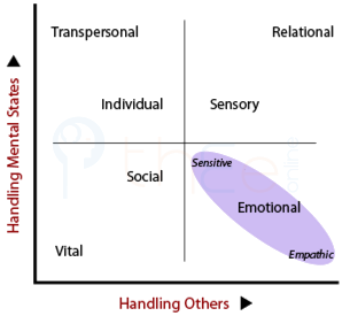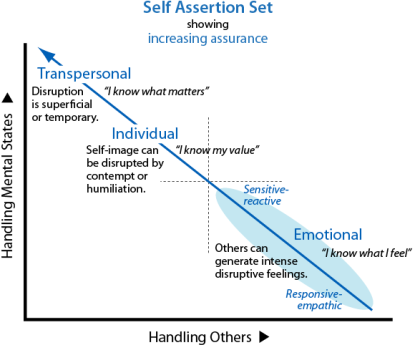Assertion or Confirmation: I
Two Diagonal Sets: Approach Duality

It is evident from the diagram that the generate two diagonal sets. These two sets handle in opposite ways as follows:
- Bottom R — Upper L: These use which can ensure continuity based on personal autonomy.
- Bottom L — Upper R: These use external confirmation which can ensure positive support from a reliable source.
Both requirements are so central to a comfortable existence that most of us have a preferred from each diagonal-set.
See below: Comparison of on the diagonal.
See next Topic: Comparison of on the External Confirmation diagonal.
See later: Exploration of natural pairings using each diagonal.
Self-Assertion
is fundamental to the that lie along the diagonal that stretches from bottom right to top left.
- asserts: "I know what I feel".
In the face of a trivial or stressful event, others often expect or even demand a certain response, typically based on convention and ignoring individuality. The emotional assertion deals with any external effort to impose or constrain, which itself may be destabilizing. Refusal to feel in ways that others expect is an expression of autonomy and distinctiveness not requiring further justification. - asserts: "I know my value!"
Those who use this see choices as affecting self-esteem and as an opportunity to assert an identity. Being authentic ("I know who I am") requires feeling autonomous. To avoid feeling shame or losing face, a person may well make and follow through on self-protective or self-assertive choices, even if counter-productive or liable to engender dislike or disapproval.

- asserts: "I know what matters!"
This assertion effectively makes you the judge of all events and proclaims autonomy. Nothing that happens and nothing that anyone says or thinks need then affect you. However improbable to others, it is possible because what really does matter is always viewed as beyond visible causes: e.g. natural flow, inherent divinity, God's will, union with the cosmos &c.
Security
is inherently liable to be asocial or even anti-social, and there is a desire for protection against others who may object. No can provide total protection against disruption or social oppression. However, vulnerability and insecurity are the issue. The inviolability or impregnability of the self increases in moving up the diagonal which generates an increase in self-assurance.
- provides the lowest assurance because emotions have a strong instinctive basis and can erupt without warning. Others can deliberately provoke a wide variety of emotions, both positive (like affection, sadness) and negative (like fear, envy, jealousy). If not provoked, any emotional state may be based in your realities, be defensive or be part of your attempt to manipulate others.
- The form is more open and flexible, i.e. most vulnerable and least assured in this regard.
- The form provides more assurance for the sense of self. It sets up emotional expectations and defences that may be quite rigid and mostly unconscious.
- is significantly more assured because the self-concept is a construct which has a strong rational or cognitive basis, as well as emotive elements. It is never fully realistic, but it can be actively protected and defended. Self-assertion allows a person to resist criticism and emotional attacks. However, direct attacks on the self-image through public exposure of personal flaws and failures, as may occur with targeted humiliation or contemptuous attitudes, can be destabilizing.
- is the most assured method because the claim to know what matters means that whatever transpires can be deemed "not to matter". The dictum, 'this too shall pass', allows a cosmic perspective that enables troubles, invariably transient, to be borne patiently. Even if sudden and surprising misfortune or disruption does lead to destabilization, recovery tends to be rapid.
Methods on the Other Diagonal
The practice of self-assertion is a universal human requirement. However, being self-assertive does not ensure the needed in the on the external confirmation diagonal; and not being assertive does not weaken their effectiveness.![]() Details:
Details:
- Consider the other diagonal with methods using external confirmation.
- Continue by exploring the quadrants.
- Explore possibilities for pairing methods.
Originally posted: 17-Oct-2014. Last updated: 19-Dec-2014.